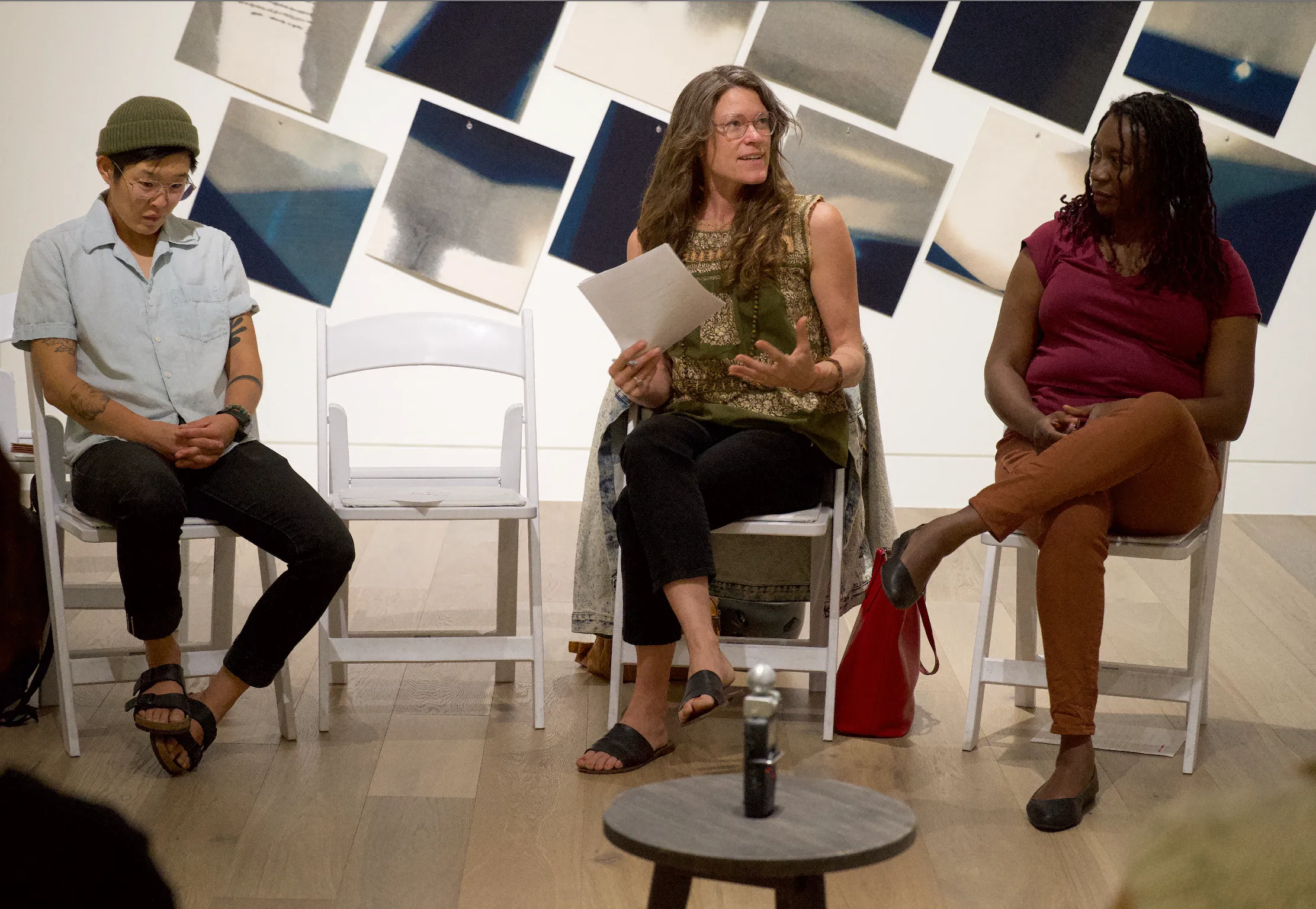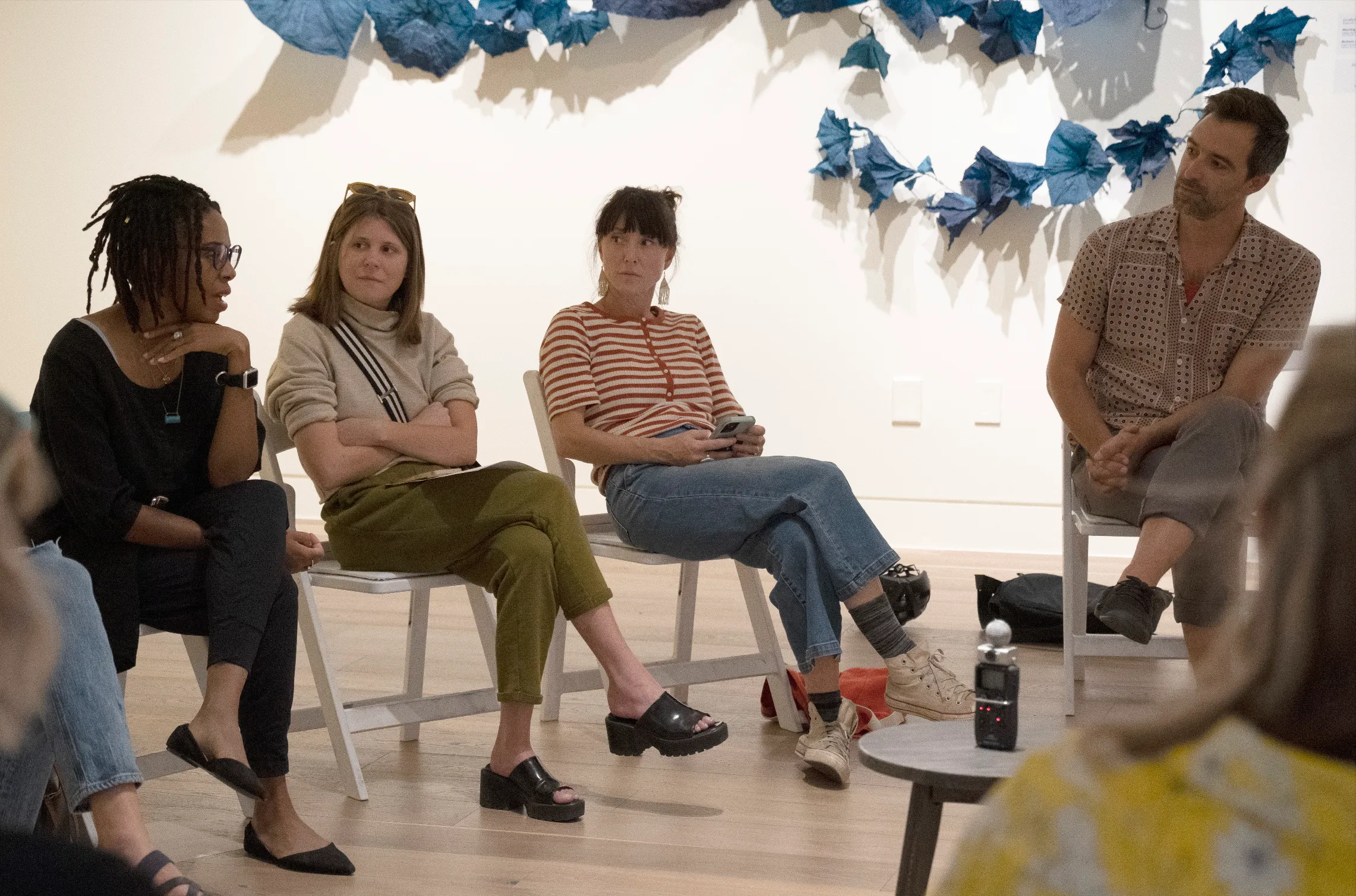Subversive Stitch: Craft in 2023
Against the backdrop of the Denver Botanical Gardens exhibition, Indigo, Tilt West’s September roundtable participants passionately discussed the intersection of Art and Craft through the lens of Equity, Representation, and Contemporary Politics. Prompter Rebecca Peebles brought years of exploring repetitive, meditative practices rooted in craft for creative and contemplative ends to the conversation. Resources provided before the discussion featured leading contemporary artists using craft practices to dissect the complexities of our modern world. As Peebles asserted in her written prompt for the event, “Craft artists and aesthetic thinkers must now courageously put their hands and hearts back into the work of defining art.” [1]
One theme united the conversation: the concept of craft being “radical.” Peebles, for example, embodies radical approaches to her art and healing. Roundtable participants discussed radical acts of personal and communal well-being; notions that radicalism lies at the heart of craft, which is the revolutionary foundation of our daily lives through hands-on engagement; and the intrinsic radical nature of craft itself.

In his introduction to Radical Lace and Subversive Knitting, the catalog for a 2007 exhibition at the Museum of Arts & Design, David Revere McFadden asks, “How does something as innocent and harmless as knitting become subversive? How can lace serve radical ends?” [2] This exhibition showed the transformative power artists have through traditional craft techniques. The familiarity of these techniques creates an accessible entry into work that gradually reveals radical content, such as calls to action and visions for a better future.
One artist from this exhibition, Cal Lane, used a plasma cutter as her needle and thread to cut elegant lace patterns in steel car hoods, connecting the history of labor-intensive craft to the mass production of the contemporary automotive industry. “Lane’s work is paradoxical: feminine and masculine associations play against each other; the techniques of industry and handicraft meet; delicate designs overtake durable materials; and positive and negative spaces create a beautiful play of light and shadow merging the high art connotations of sculpture with the aesthetic of craft.” [3]
For roundtable participant Heather Schulte, an interdisciplinary artist based in Colorado, craft transcends cultural and ideological boundaries, offering a common ground for new frontiers of artistic language. Schulterecently discussed the intersection of personal and public forms of language and communication with the Textile Society of America. “I also see textiles as a form of text, as they hold within them the stories of both the animals or plants that are the material and the humans who create new items with said material. Across history, they have also been used as storytelling devices, from quipu knotting systems to medieval tapestries, subversive samplers to contemporary quilts. I draw upon this rich history and utilize modern forms of coding to embed my stitches with messages and commentary on the issues of our day.” [4]
Other participants in the Tilt West roundtable included artists, crafters, musicians, a coffee barista, an avid gardener, and a museum curator aptly named Hannah Craft. All shared personal experiences that supported this unique, organic conversation while exploring craft through the eyes of equity, representation, and contemporary politics. A simple Google search of equity + craft yields 115,000,000 results. As Peebles’ opening statement mentioned, “Artists today are using craft media to claim the variability, diversity, and intersectionality of personhood expressed through creative practice.” [5]

Craft platforms today address equity in their mission and vision statements as an impetus for change. One craft council wants to foster “livelihoods and ways of living grounded in the artful work of the human hand”while using craft as a catalyst to “draw on the rich legacy of openness and its deep roots in all cultures.” [6] Another international craft forum intends to “Foster awareness among people in the arts globally to prevent our artists from being perceived as artisans rather than true artists.” [7] and to “connect Black craftspeople to the power of place.” [8]
As the discussion continued, roundtable participants challenged the use of labels that tend to separate craft from art and craft artists from fine artists. Setting aside the endless debate of whether craft is “high” or “low” art, one might consider the Four C Model of Creativity researched by creative psychologists James Kaufman and Ronald Beghetto. Grounded in the belief that there is no hierarchy in creativity, the Four C Model of Creativity identifies varying levels of fluid creativity. Little-c creativity, or everyday creativity, includes songwriting, inventing new recipes, or decorating a room. Big-C creativity, or genius creativity, has a broader impact and is often associated with the culmination of work from publications to exhibitions. Mini-c creativity, or personal creativity, refers to new and personally meaningful interpretations, ideas, and insights. Pro-Ccreativity, or expert creativity, describes individuals who have reached a professional level after years of experience and training. [9]
This model helps people overcome the idea that they are not creative if they don’t fall into the Big-C or genius creativity category. An example of this is someone believing they are not creative because they can’t sing as well as Beyoncé. [11] The Four C Model helps expand the idea of creativity. Whether you are making a significant impact on society or making Thanksgiving dinner, everyone makes creative contributions to the world. Educational psychologist Dr. Ruth Richards reminds us that everyday creativity “is not only universal but necessary to our very survival as individuals and as a species.” [12]
As the character of Madame Defarge states in A Tale of Two Cities by Charles Dickens, a skill becomes useful when and where it is needed to effect revolutionary change. In this 1859 classic, Madame Defarge encoded a secret list of aristocrats and enemies of the Revolutionary government in the stitches of her knitting. [13] While many things have changed since 1859, it is evident that our response to using our hands to implement world change has remained the same. Artists continue to harness the transformative radical power of craft and subversive stitch, advocating equity, social justice, mental health, and environmental causes to foster a brighter future.